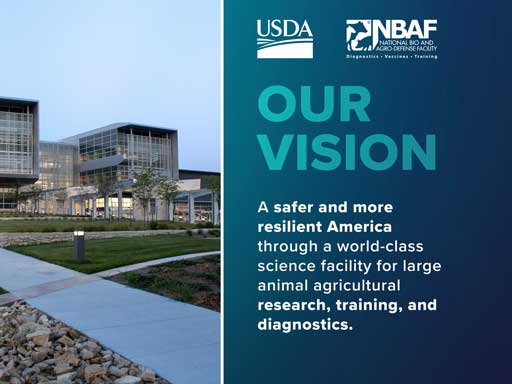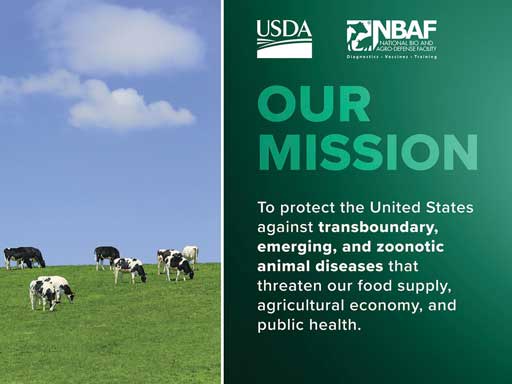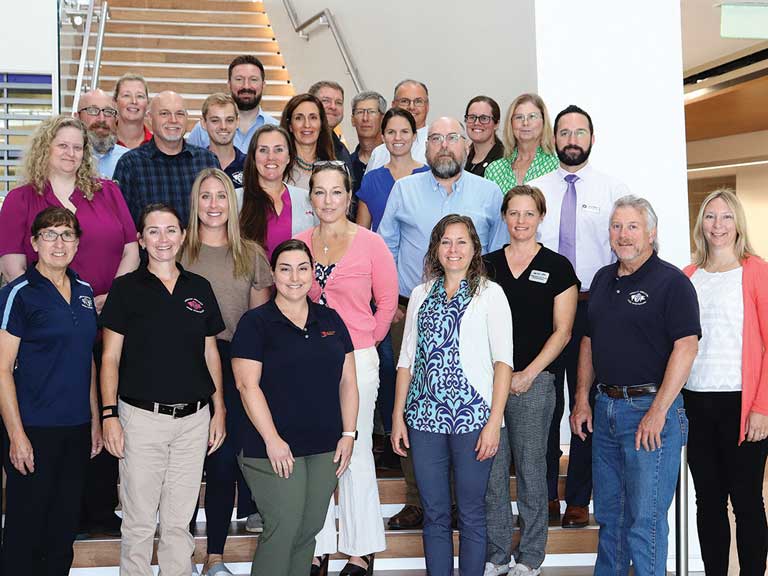What happens at the National Bio and Agro-Defense Facility (NBAF) in Manhattan, Kansas is not classified and is not secret. In fact, staff at NBAF are excited to share their vision, mission, impressive facility, and plans for the near future. A forward-thi nking communications team developed messaging for animal and public health stakeholders, policy decision makers, and the public long before the site was selected in 2009 and construction began on the $1.25 billion, 574,000-ft2 facility. They also have essential information that all swine veterinarians should know (USDA NBAF Communications, email, September 2023).


Top 10 things all swine veterinarians should know about NBAF
1. The US Department of Agriculture (USDA) NBAF is a technologically advanced facility in Manhattan, Kansas that will safely and securely support USDA’s mission to protect livestock from foreign, emerging, and zoonotic diseases.
2. While scientists at the Plum Island Animal Disease Center in New York have been successful in their role of protecting the swine industry, the center is more than 68 years old and does not have the capacity to expand the mission to cover emerging and zoonotic diseases.
3. The NBAF has biosafety level (BSL)-2 and -3 containment laboratories and is the first facility in the United States with BSL-4 containment capable of housing large livestock. The containment laboratories at NBAF require the highest level of safety protocols and equipment so scientists can safely study and diagnose a variety of high-consequence animal pathogens.
4. The NBAF will be home to the Animal and Plant Health Inspection Agency’s Foreign Animal Disease Diagnostic Laboratory (FADDL) which conducts 24/7 diagnostic testing, emergency response, training for state and federal veterinarians, and manages two vaccine banks. Surrounded by the industry NBAF seeks to protect, FADDL’s ability to receive diagnostic samples and conduct timely confirmatory diagnostic testing is critical to mitigating a foreign animal disease outbreak.
5. Manhattan, Kansas was selected as the site for the NBAF after an extensive 3-year site selection process. This location allows scientists to leverage proximity to academic researchers and the highest concentration of animal health companies in the nation, known as the Animal Health Corridor, for potential key collaborations.
6. The expanded training facilities at NBAF will allow USDA to increase the number of state and federal veterinarians trained by the FADDL team every year as part of the Foreign Animal Disease Diagnostician Course. This training helps veterinarians learn to recognize foreign animal diseases in swine and collect diagnostic samples that would then be sent to FADDL for confirmatory testing should an outbreak occur.
7. The NBAF will be home to 3 Agricultural Research Service units, 2 of which are new to USDA, to continue research on foot-and-mouth disease, African swine fever, and classical swine fever as well as research on arthropod-transmitted diseases and diseases that can transfer between animals and people such as Japanese encephalitis virus and Nipah virus.
8. The unique capabilities of NBAF, such as the size and number of animal rooms within containment, will allow scientists to fill knowledge gaps related to animal pathogens not previously possible in the United States or even across the world. For example, scientists will seek to understand swine diseases at various life stages and test vaccines, antivirals, and other veterinary medical products.
9. The Biologics Development Module is a unique proof-of-concept production facility inside NBAF’s secure campus. It is designed to enhance and expedite the transition of innovations from research to commercially-viable medical products such as vaccines and diagnostics.
10. It will still be a couple of years before the full mission is transferred from Plum Island to NBAF as USDA staff work to ensure a safe and secure transfer and standup of NBAF’s science programs through a phased approach of crawl, walk, jog, and run.

AASV leader impressions of NBAF
In late August, AASV leaders were invited to tour NBAF. Here, they share observations they considered of particular importance for swine veterinarians.
“NBAF is government money very well spent. I was impressed with motivated, intelligent staff putting forward an ultra-high end facility advancement sufficient to study very real, clear, and present danger in animal health. I felt I was walking in a live “Disney-Marvel Movie.” Our guide was an engineer with a Bachelor’s degree in physics who started on the maintenance team. He knew every bolt, monitoring device, and service purpose of the building.” – Dr Bill Hollis, AASV President
“There is four times the amount of space and four times the number of employes to fully operate the laboratories (ie, there are 400 support staff for every 100 laboratory employees). There are three floors of air handling, HVAC, and waste handling for one laboratory floor.” – Dr Melissa Billing, AASV District 1
“Biocontainment is the biggest priority, especially being in town across from the veterinary medical school and in food-animal country. They have a community engagement group to help with the social messaging. The staff who gave tours were very engaged and understood the importance of the work being done for our industry. I was impressed by the caliber of people already at the facility.” – Dr Sara Hough, AASV District 2
“The mission of NBAF is important to all of us - veterinarians, livestock producers, and the general public.” – Dr Stephen Patterson, AASV District 3
“I was pleasantly surprised that all of the different groups seem to be working together at NBAF, instead of independently.” – Dr Megan Inskeep, AASV District 4
“Although it is located in the middle of the United States, this facility is equipped with state-of-the-art safety and lockdown mechanisms that will withstand natural disasters and other potential threats to safely contain the pathogens that are studied in the BSL-2, -3, and -4 laboratories.” – Dr Attila Farkas, AASV District 5
“I was most impressed by the presence of the Biologics Development Module (BDM) which is a unique proof-of-concept production facility within NBAF. This module is designed to enhance and expedite the transition of innovations from research to commercially viable vaccines and diagnostics. In my conversation with the director of the BDM, it was refreshing to hear their deep understanding of the process and need for the commercialization of innovations created at NBAF.” – Dr Mike Senn, AASV Past-President
“The redundancies in place for biosafety to safeguard all working with BSL-3 and -4 agents is impressive.” – Dr Chris Rademacher, AASV District 6
“Each suit required to enter the BSL-4 costs about $10,000.” – Dr Maryn Ptaschinski, AASV District 7
“I was impressed with the approach taken by the team at NBAF to ensure safety and security. There was an all-encompassing monitoring system surrounding a sophisticated design of negative pressure and filtration to contain aerosolized risk. Additionally, there were multiple systems in place to handle fomite contamination, waste management, and carcass management that were more than sufficient to ensure biocontainment. I appreciated the approach of putting the processes in place before actually starting up the facility in order to make sure everyone is trained, and the equipment and technology are functioning properly. The facility engineering accounts for severe weather threats, backup systems in the case of equipment or power failure, and has automated timed processes for people entering and exiting the containment facility.” – Dr Christine Mainquist-Whigham, AASV District 8
“I was impressed with the overall security and culture of the NBAF team. There were several thoughts and actions in place to ensure that the security (especially from a biocontainment standpoint) of the building, data, and processes were of the highest importance to the team. The steps to ensure employee, national, and international security for food, human, and agricultural safety were taken and well thought through. In addition, I appreciated the culture of the NBAF team and demonstrating that transparency with the community and external stakeholders is critical.” – Dr Alyssa Betlach, AASV District 9
“This impressive BSL-4 laboratory is the only one in the nation capable of housing large animals.” – Dr Angela Baysinger, AASV President-Elect
“The tornado and high-wind sensors are state of the art and automatically activate the built in defenses to protect the people, animals, and research inside. The building windows are designed to take a hit from a flying pickup truck and the vents seal automatically. They can last 2 weeks in the winter on the generators.” – Dr Susan Detmer, AASV District 11
“I was amazed at the amount of forethought and planning that went into everything, the number of fail-safes that had been put into place, and the amount of training and planning that has gone into potential emergency situations. My favorite part was that the laboratories had windows and that they found a way to make them secure and still provide that aspect for their laboratory employees.” – Dr Hunter Everett, AASV Student Delegate
“Overall, I came away with confidence that the facility is safe and provides vital, unique research support for American animal agriculture. It is an asset that furthers America’s global leadership in safe food production.” – Dr Locke Karriker, AASV Vice-President
Abbey Canon, DVM, MPH, DACVPM
Director of Public Health and Communications
